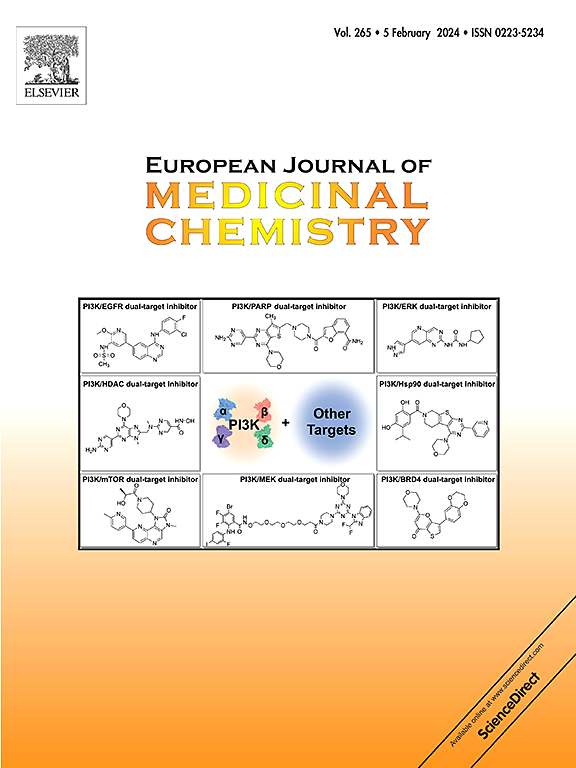Discovery of novel thiazolylhydrazone derivatives as potent anti-cancer agents inducing ferroptosis via direct NRF2 inhibition
IF 6
2区 医学
Q1 CHEMISTRY, MEDICINAL
引用次数: 0
Abstract
Nuclear factor erythroid 2-related factor 2 (NRF2/NFE2L2) is a key transcription factor regulating antioxidant defense and iron metabolism. Its activation confers ferroptosis resistance to cancer cells and promotes tumor progression. In this study, we designed and synthesized a novel series of thiazolylhydrazone derivatives (1a-1g, 2a-2e, and 3a-3i) as NRF2 inhibitors and evaluated their antiproliferative activities against a panel of cancer cell lines. Among them, PhcY emerged as the most potent compound. Molecular docking studies demonstrated its strong binding affinity to the NRF2 active site, indicating direct inhibition. PhcY induced ferroptosis in MCF-7 breast cancer cells via NRF2 inhibition. Mechanistic investigations revealed that PhcY disrupted cellular iron homeostasis, facilitated ferritin degradation, and ultimately triggered ferroptosis. In vivo, PhcY demonstrated significant antitumor efficacy in MCF-7 xenograft-bearing mice at a dose of 10 mg/kg. These findings highlight the potential of thiazolylhydrazone derivatives, particularly PhcY, as NRF2-targeted ferroptosis inducers for cancer therapy.

新型噻唑腙衍生物通过直接抑制NRF2诱导铁下垂的有效抗癌药物的发现
核因子红系2相关因子2 (NRF2/NFE2L2)是调控抗氧化防御和铁代谢的关键转录因子。它的激活赋予铁下垂对癌细胞的抗性并促进肿瘤进展。在这项研究中,我们设计并合成了一系列新的噻唑基腙衍生物(1a-1g, 2a-2e和3a-3i)作为NRF2抑制剂,并评估了它们对一组癌细胞的抗增殖活性。其中,PhcY是最有效的化合物。分子对接研究表明其与NRF2活性位点有较强的结合亲和力,具有直接抑制作用。PhcY通过抑制NRF2诱导MCF-7乳腺癌细胞铁下垂。机制研究表明,PhcY破坏细胞铁稳态,促进铁蛋白降解,最终引发铁下垂。在体内,PhcY在10 mg/kg剂量的MCF-7异种移植小鼠中显示出显著的抗肿瘤作用。这些发现突出了噻唑酰腙衍生物,特别是PhcY,作为nrf2靶向的铁下垂诱导剂用于癌症治疗的潜力。
本文章由计算机程序翻译,如有差异,请以英文原文为准。
求助全文
约1分钟内获得全文
求助全文
来源期刊
CiteScore
11.70
自引率
9.00%
发文量
863
审稿时长
29 days
期刊介绍:
The European Journal of Medicinal Chemistry is a global journal that publishes studies on all aspects of medicinal chemistry. It provides a medium for publication of original papers and also welcomes critical review papers.
A typical paper would report on the organic synthesis, characterization and pharmacological evaluation of compounds. Other topics of interest are drug design, QSAR, molecular modeling, drug-receptor interactions, molecular aspects of drug metabolism, prodrug synthesis and drug targeting. The journal expects manuscripts to present the rational for a study, provide insight into the design of compounds or understanding of mechanism, or clarify the targets.

 求助内容:
求助内容: 应助结果提醒方式:
应助结果提醒方式:


